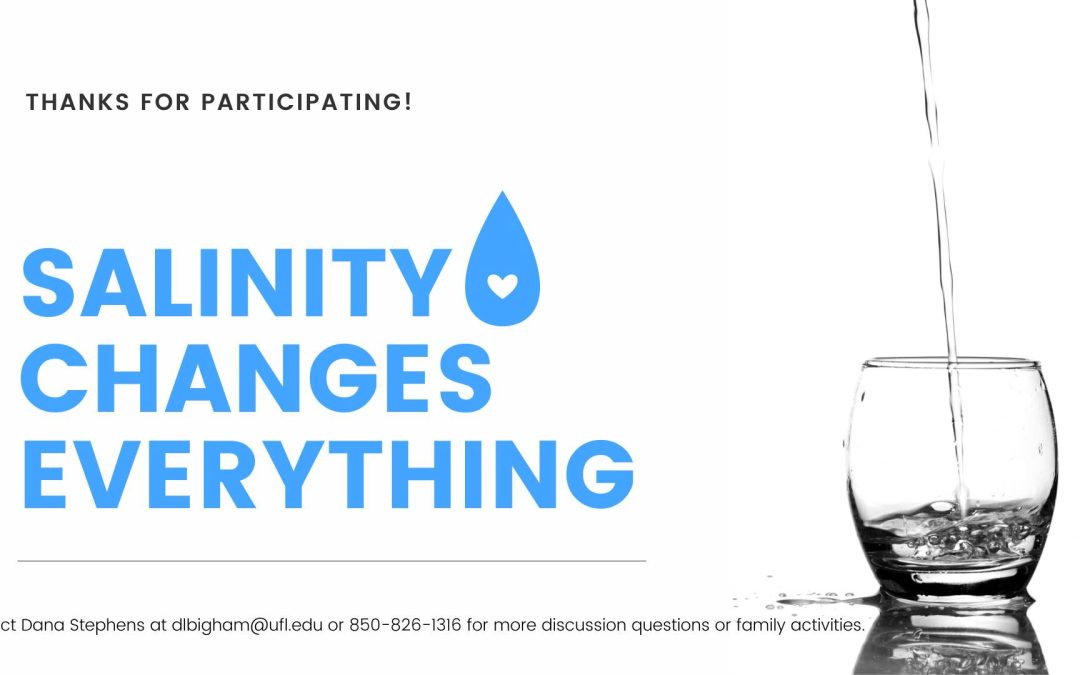
by Dana Stephens | May 3, 2024
Understanding Salinity in Northwest Florida’s Waters with a Family Activity
Dana Stephens, 4-H Agent
Salinity is the amount of total dissolved salts in water. This includes all salts not just sodium chloride, or table salt. Salinity is important in aquatic environments as many flora and fauna depend on salt and the level of dissolved salts in the water for survival. People interested in the composition of water frequently measure chemical and physical components of water. Salinity is one of the vital chemical components measured and often measured by a device determining how readily electrical conductance passes between two metal plates or electrodes. These units of electrical conductance, the estimate of total dissolved salts in water, is described in units of measurement of parts per thousand (PPT).
At the large scale, Earth processes, such as weathering of rocks, evaporation of ocean waters, and ice formation in the ocean, add salt to the aquatic environment. Earth processes, such as freshwater input from rivers, rain and snow precipitation, and ice melting, decrease the concentration of salt in the aquatic environment. Anthropogenic (human-induced) activities, such as urbanization or atmospheric deposition, can also contribute to changes in salinity.
Salinity and changes in salinity affect how water moves on Earth due to contrasts in the density of water. Water containing no dissolved salts is less dense than water containing dissolved salts. Density is weight per volume, so water with no dissolved salts (less dense) will float on top of water with dissolved salts (denser). This is why swimming in the ocean may feel easier than swimming in a lake because the denser water provides increased buoyancy.
Northwest Florida is a unique place because we have a variety of surface waters that range in salinity. There are ponds, lakes, streams, rivers, and springs, which have no to low salinity levels (0 to 0.5 PPT), and commonly referred to as freshwater systems. We house six estuaries—Perdido Bay, Pensacola/Escambia Bay, Choctawhatchee Bay, St. Andrews Bay, St. Joseph Bay, and Apalachicola Bay. Estuaries are bodies of water with freshwater input(s) (e.g., rivers) and a permanent opening to the ocean (e.g., Destin Pass in the Choctawhatchee Bay). Estuarine waters are termed brackish water (0.5 to 30 PPT) due to the dynamic changes in salinity at spatial and temporal scales. Waterbodies with an even more dynamic change in salinity are the coastal dune lakes Northwest Florida’s Walton and Bay Counties. Coastal dune lakes are waterbodies perched on sand dunes that intermittently open and close to the Gulf of Mexico. Sometimes these waterbodies are fresh and sometimes they have the same salinity as the Gulf of Mexico, like after a large storm event. Finally, the Gulf of Mexico, or ocean, has the highest salinity (> 30 PPT) among the waterbodies of Northwest Florida.
Here is an educational activity for the family to explore salinity and how salinity differs among Northwest Florida waters.






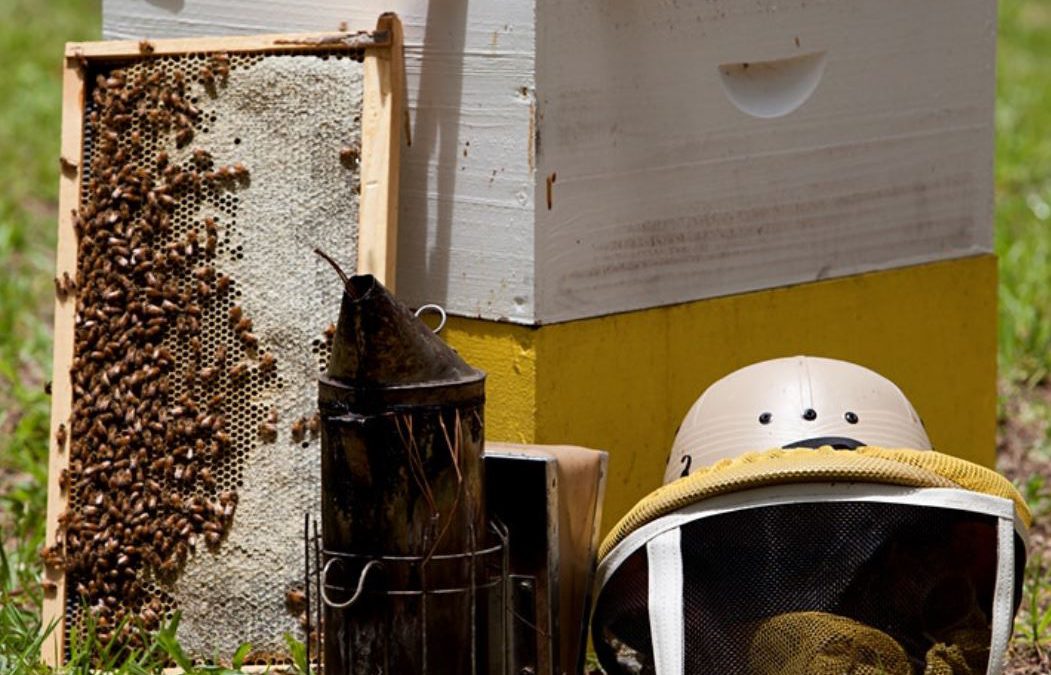
by Ray Bodrey | Apr 22, 2022
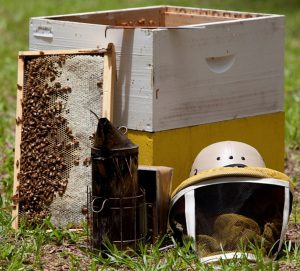
The University of Florida IFAS Extension and the Beekeeping in the Panhandle Working Group has once again teamed up to offer the 9th Annual Beekeeping in the Panhandle Conference on Friday May 6th and Saturday May 7th 2022 at the Washington County Ag Center Auditorium.
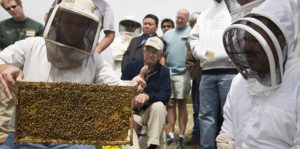
This year’s event will feature: Hands-on open hive experiences, presentations on the latest in research-based beekeeping management practices, interaction with expert beekeepers, vendors with beekeeping equipment, and hive products. Door prizes will be available as well!
The registration fee for the event will be $35 for one day or $55 for both days per person over 12, and $15 per day for kids 12 and under.
The activities will take place from 8:00 am – 5:00 pm Central each day and will include catered lunch.
Location: 1424 Jackson Avenue, Chipley, FL
Ways to register:
Registration link: https://www.eventbrite.com/e/9th-annual-beekeeping-in-the-panhandle-conference-trade-show-tickets-269199873067
Or, drop by the Washington County Extension Office in Chipley.
For more information contact Washington County Extension Office at (850) 638-6180
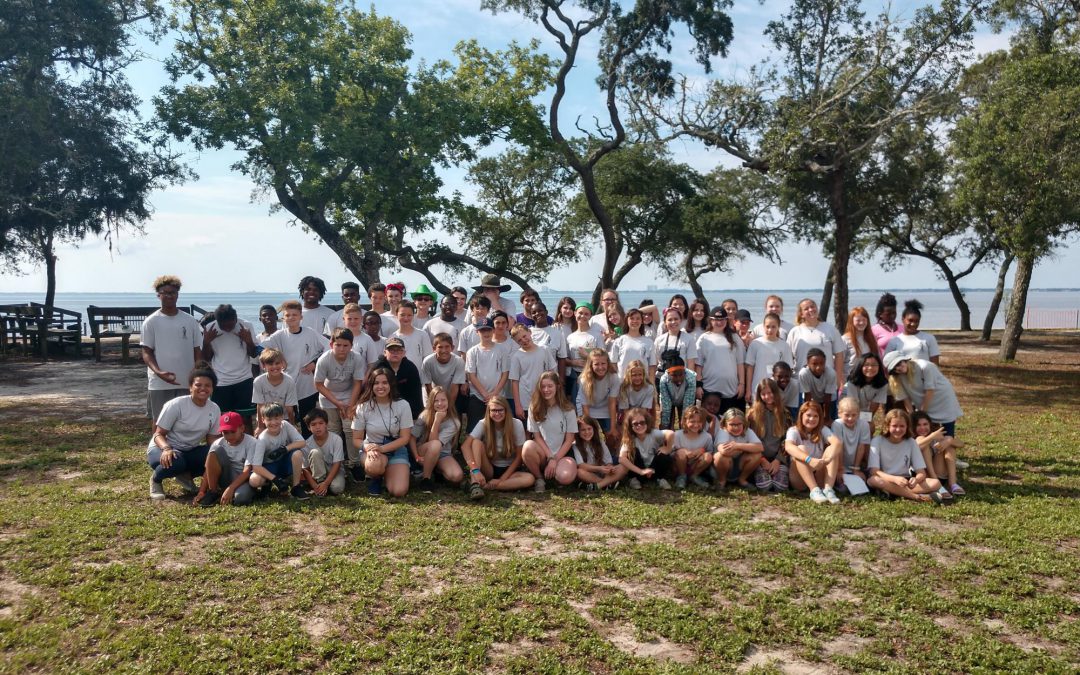
by Rick O'Connor | Mar 4, 2022
Nestled on the shore of the Choctawhatchee Bay across from Destin in Okaloosa County you will find 4-H Camp Timpoochee. Its private facilities, open spaces, waterfront view, and beautiful sunsets allow campers, students, and guests to play, learn, and work in a safe and relaxing environment. During a stay at Camp Timpoochee, you will experience memorable camp activities in a beautiful environment that will bring you back year after year. Camp Timpoochee provides modern conveniences, within the traditional camp setting, to combine a relaxed camp atmosphere with today’s camping needs.
If you have a child aged 6-16, you might want to consider sending them on a summer adventure at 4-H Camp Timpoochee located in Niceville, Florida. This camp allows campers first-hand experience with Florida’s marine and coastal environment above and below the waterline. Programs are designed to bring science to life in this living laboratory with the forest and bay providing classrooms for hands-on learning. Participants have an opportunity to learn while seining, cast netting, fishing, snorkeling, kayaking, going on a nature hike, or shooting archery.
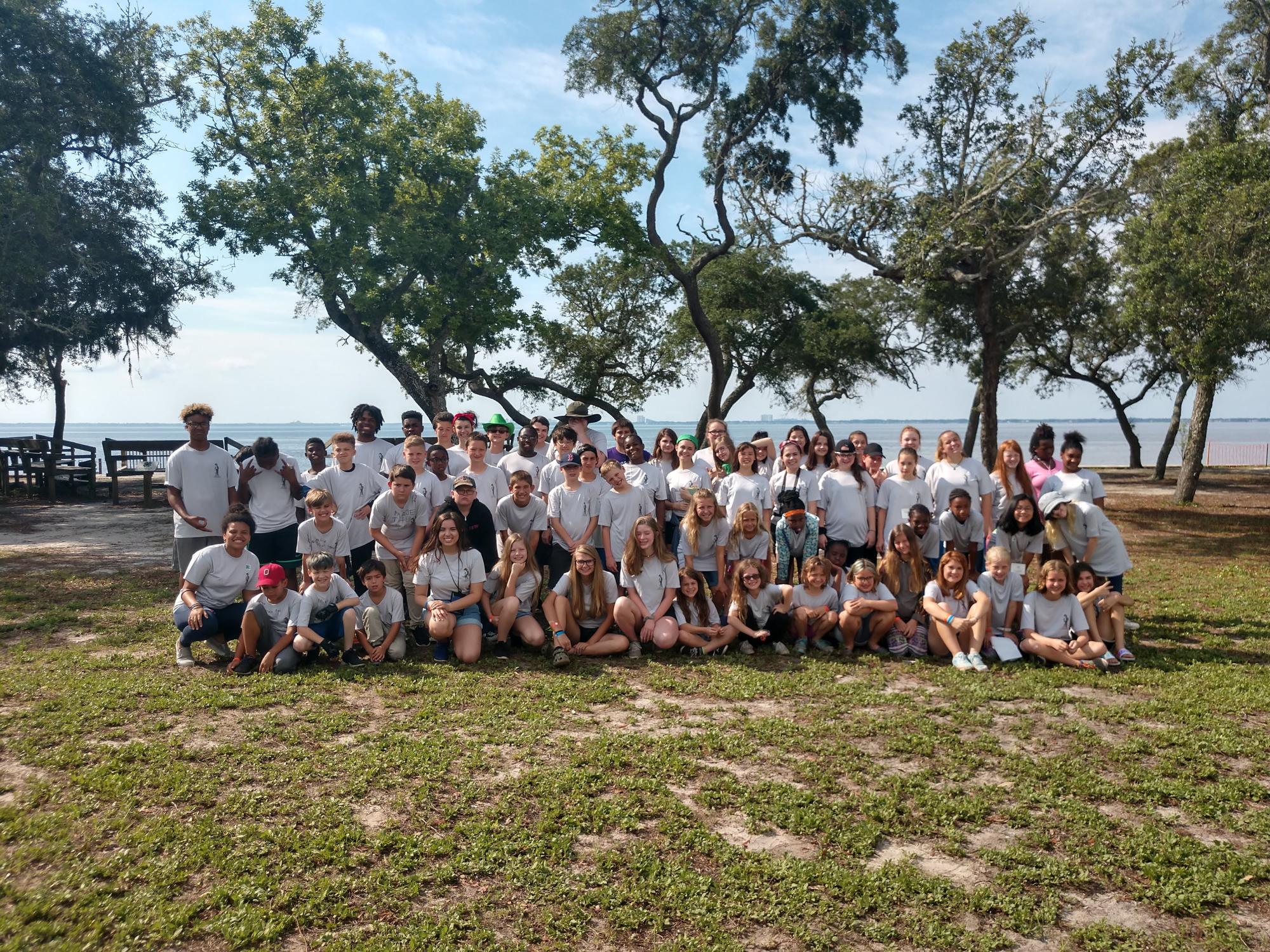
These are Happy Campers!
Photo: Brian Estevez
4-H summer camping programs provide opportunities for youth to sense of safety and security within a new environment away from home. It can provide that first experience being away from family in a residential setting. Youth are building their independence by having cabin responsibilities, getting to and from scheduled events on time, and gaining exposure to working together as a team. Camp life provides some early opportunities for children to learn the concept of generosity. Helping others in need, whether it is a forgotten item, simply sharing your free time with someone new, or demonstrating care and concern to someone who is feeling left out are all character-building skills that are part of the camp learning environment.
Established in 1926, 4-H Camp Timpoochee is the oldest continually operating 4-H camp in Florida. It provides the perfect outdoor living classroom. With more than a third of a mile of shoreline, it has become the perfect escape from the hustle of the outside world offering a place to disconnect from technology and reconnect with people. Serving more than 800 campers each summer, 4-H Camp Timpoochee provides multiple opportunities for youth to experience new adventures, step outside their box and make life-long friends and memories.
Open year round, 4-H Camp Timpoochee is more than just a summer camp. It offers opportunities for rental groups to enjoy its tranquil and multi-purpose facility through retreats, weddings, reunions and more! Offering lodging spaces, meal service, and meeting spaces, it has quickly become a unique location for various youth and adult organizations far and wide to enjoy.
So, if you want your child to get outdoors and leave electronics behind, consider sending him/her to 4-H Camp Timpoochee to learn about the great outdoors and Florida marine life. 4-H is one of the nation’s most diverse organizations and includes people from all economic, racial, social, political, and geographic categories. There are no barriers to participation by any young person. Participants are given the opportunity to engage in activities that hold their personal interest, while being guided by adult volunteers.
For more information on 4-H Camp Timpoochee and their summer program for 2022, please visit https://florida4h.ifas.ufl.edu/camps/camp-timpoochee/summer-camps/.












